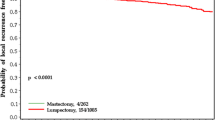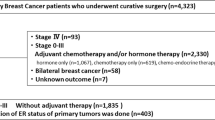Abstract
The National Institutes of Health, USA sponsored a Consensus Development Conference on November 1-3, 2000 to review several major questions regarding the adjuvant treatment of breast cancer. A non-governmental group of oncology experts was selected to review clinical trial data and judge the evidence presented by 33 breast cancer researchers. Their conclusions resulted in the following recommendations: (1) Prognostic factors critical for determining risk of recurrence are age, axillary lymph node status, tumor size, histologic type and grade and hormone receptor status. (2) Tamoxifen, administered for 5 years, significantly improves long-term survival for women of all age groups with hormone receptor-positive tumors. Ovarian ablation also prolongs survival in premenopausal women. (3) Multi-agent chemotherapy of 4-6 months duration is associated with an improvement in survival in both hormone receptor-positive and -negative tumors. Anthracyclinecontaining regimens offer the greatest survival advantage. The role of taxanes is uncertain but they may be useful in selected patients with node-positive tumors. Women with small, node-negative tumors, women over age 70, and those with tumors of favorable histologic subtype (mucinous or tubular) may not require chemotherapy. (4) Adjuvant radiotherapy to the regional lymph nodes and chest wall following mastectomy is indicated for women with 4 or more axillary nodes. (5) Physicians should employ effective visual aids to help them present a complete and balanced view of the absolute benefits versus the side-effects of adjuvant treatments. Important avenues of future research were also discussed and suggestions were made.
Similar content being viewed by others
Abbreviations
- NIH:
-
National Institutes of Health
- CDC:
-
Consensus Development Conference
- EBCTCG:
-
Early Breast Cancer Trialists1 Collaborative Group
- ECOG:
-
Eastern Cooperative Oncology Group
- CALGB:
-
Cancer and Leukemia Group B
- IBCSG:
-
International Breast Cancer Study Group
- NSABP:
-
National Surgical Adjuvant Breast and Bowel Project
References
Guidelines for the planning and management of NIH Consensus Development Conferences. Bethesda (MD): National Institutes of Health, Office of the Director, Office of Medical Applications of Research; 1993 May. 13p.
Moxley JH, Allegra JC, Henney J,et al: Treatment of primary breast cancer: Summary of the National Institutes of Health Consensus Development Conference.JAMA 244: 797–803, 1980.
Consensus Conference. Adjuvant chemotherapy for breast cancer.JAMA 254:3461–3463, 1985.
NIH consensus conference. Treatment of early-stage breast cancer.JAMA 265:391–395, 1991.
National Institutes of Health Consensus Development Conference Statement: Adjuvant Therapy for Breast Cancer, November 1-3, 2000.J Natl Cancer Inst 93: 979–989, 2001.
Fitzgibbons PL, Page DL, Weaver D,et al: Prognostic factors in breast cancer: College of American Pathologists Consensus Statement 1999.Arch Pathol Lab Med 124: 966–978, 2000.
Braun S, Pantel K, Muller P,et al: Cytokeratin-positive cells in the bone marrow and survival of patients with stage I, II or III breast cancer.N Engl J Med 342: 525- 533, 2000.
Aebi S, Gelber S, Castiglione-Gertsch M,et al: Is chemotherapy alone adequate for young women with oestrogen-receptor-positive breast cancer?Lancet 55: 1869–1874, 2000.
Early Breast Cancer Trialists’ Collaborative Group. Tamoxifen for early breast cancer: an overview of the randomized trials.Lancet 351: 1451–1467, 1998.
Fisher B, Anderson S, Wolmark N,et al: Chemotherapy with or without tamoxifen for patients with ER-negative breast cancer and negative nodes: Results from NSABP B-23.Proc Am Soc Clin Oncol 19: 72a (abstract), 2000.
Hutchins L, Green S, Ravdin P,et al: CMF versus CAF with and without tamoxifen in high-risk node-negative breast cancer patients and a natural history follow-up study in low-risk node-negative patients: first results of intergroup trial INT 0102.Proc Am Soc Clin Oncol 17: 1a (abstract), 1998.
Stewart HJ, Forrest AP, Everington D,et al: Randomised comparison of 5 years of adjuvant tamoxifen with continuous therapy for operable breast cancer.Br J Cancer 74: 297–299, 1996.
Tormey DC, Gray R, Falkson HC: Postchemotherapy adjuvant tamoxifen beyond five years in patients with lymph node-positive breast cancer.J Natl Cancer Inst 88: 1828–1833, 1996.
CRC Trials Unit Birmingham. Adjuvant tamoxifen treatment offer more? (aTTom). Protocol. CRC Trials Unit, Clinical Research Block, Queen Elizabeth Hospital, Birmingham B15 2TH, UK.
Clinical Trial Service Unit, Radcliffe Infirmary, Oxford. Adjuvant tamoxifen longer against shorter (ATLAS). Protocol. April, 1995. ATLAS Office, Clinical Trials Service Unit. Radcliffe Infirmary, Oxford OX2 6HE, UK.
Scottish Cancer Trials Group and ICRF Breast Unit, Guy’s Hospital, London. Adjuvant ovarian ablation versus CMF chemotherapy in premenopausal women with pathological stage II breast carcinoma: the Scottish trial.Lancet 341: 1293–1298, 1993.
Ejlertsen B, Dombernowsky P, Mouridsen Ht Kamby C,et al: Comparable effect of ovarian (OA) and CMF chemotherapy in premenopausal hormonal receptor positive breast cancer patients (PRP).Proc Am Soc Clin Oncol 18: 66a (abstract), 1999.
Jonat W: Zoladex (goserelin) vs CMF as adjuvant therapy in pre/perimenopausal early (node-positive breast cancer: preliminary efficacy, QOL, and BMD results from the ZEBRA study (abstract).Breast Can Res Treat 1: 20, 2000.
Boccardo F, Rubagotti A, Amoroso D,et al: Cyclophosphamide, methotrexate, and fluorouracil versus tamoxifen plus ovarian suppression as adjuvant treatment of estrogen-receptor-positive pre/perimenopausal breast cancer patients: results of Italian Breast Cancer Adjuvant Study Group 02 randomized trial.J Clin Oncol 18: 2718–2727, 2000.
Jakesz R, Gnant M, Hausmaninger H,et al: Combination goserelin and tamoxfen is more effective than CMF in premenopausal patients with hormone-responsive tumors in a multicenter trial of the Austrian Breast Cancer Study Group (ABCSG).Breast Cancer Res Treat 57: 25, 1999.
Roche H, Mihura J, de Lafontan B, et al: Castration and tamoxifen versus chemotherapy (FAC) for premenopausal, node and receptor-positive breast cancer patients: a randomized trial with a 7 years median follow-up.Proc Am Soc Clin Oncol 15: 117 (abstract), 1996.
Roche HH, Kerbrat P, Bonneterre J,et al: Complete hormonal blockade versus chemotherapy in premenopausal early-stage breast cancer patients (Pts) with positive hormone-receptor (HR+) and 1-3 nodepositive (N+) tumor, results of the FASG 06 trial.Proc Am Soc Clin Oncol 19: 72a (abstract), 2000.
Davidson N, O’ Neill A, Vukov A,et al: Effect of chemohormonal therapy in premenopausal node (+) receptor (+) breast cancer: an Eastern Cooperative Oncology Group Phase IE Intergroup Trial (E5188, INT-0101).Proc Am Soc Clin Oncol 18: 67a (abstract), 1999.
Rutqvist LE: Zoladex and tamoxifen as adjuvant therapy in premenopausal breast cancer: a randomized trial by the Cancer Research Campaign (CRC) Breast Cancer Trials Group, the South-East Sweden Breast Cancer Group, Stockholm Breast Cancer Study Group and Gruppo Interdisciplinare Valutazione Interventi in Oncologia (GIVIO).Proc Am Soc Clin Oncol 18: 67a (abstract), 1999.
25) Early Breast Cancer Trialists’ Collaborative Group (EBCTCG). Polychemotherapy for early breast cancer: an overview of the randomized trials.Lancet 352: 930–942, 1998.
Seidman H, Gelb SK, Silverberg E,et al: Survival experience in the Breast Cancer Detection Demonstration Project.CA Cancer J Clin 37: 258–290, 1987.
Carter CL, Allen C, Henson DE: Relation of tumor size, lymph node status, and survival in 24,750 breast cancer cases.Cancer 63: 181–187, 1989.
Fisher B, Dignam J, Tan-Chiu E,et al: Prognosis and treatment of patients with breast tumors of one centimeter or less and negative axillary nodes.J Natl Cancer Inst 93: 112–120, 2001.
Fisher B, Brown AM, Dimitrov NV,et al: Two months of doxorubicin-cyclophosphamide with and without interval reinduction therapy compared with 6 months of cyclophosphamide, methotrexate, and fluorouracil in positive-node breast cancer patients with tamoxifennonresponsive tumors: results from the National Surgical Adjuvant Breast and Bowel Project B-15.J Clin Oncol 8: 1483–1496, 1990.
Peters WP, Rosner G, Vredenburgh J,et al: A prospective, randomized comparison of two doses of combination alkylating agents as consolidation after CAF in high-risk primary breast cancer involving ten or more axillary lymph nodes: preliminary results of CALGB 9082/SWOG 9114/NCIC MA-13.Proc Am Soc Clin Oncol 18: 1a (abstract), 1999.
Rodenhuis S, Bontenbal M, Beex L,et al: Randomized phase III study of high-dose chemotherapy with cyclophosphamide, thiotepa, and carboplatin in operable breast cancer with 4 or more axillary lymph nodes.Proc Am Soc Clin Oncol 19: 74 (abstract), 2000.
Henderson IC, Berry D, Demetri G,et al: Improved disease-free and overall survival from the addition of sequential paclitaxel but not from the escalation of doxorubicin dose level in the adjuvant chemotherapy of patients with node-positive primary breast cancer.Proc Am Soc Clin Oncol 17: 101a (abstract), 1998.
Early Breast Cancer Trialists’ Collaborative Group (EBCTCG). Favourable and unfavourable effects on long-term survival of radiotherapy for early breast cancer: an overview of the randomized trials.Lancet 355: 1757–1770, 2000.
Love RR, Cameron L, Connell BL,et al: Symptoms associated with tamoxifen treatment in postmenopausal women.Arch Intern Med 151: 1842–1847, 1991.
Fisher B, Costantino J, Redmond C,et al: A randomized clinical trial evaluating tamoxifen in the treatment of patients with node-negative breast cancer who have estrogen-receptor-positive tumors.N Engl J Med 320: 479–484, 1989.
Ganz PA, Desmond KA, Belin TR,et al: Predictors of sexual health in women after a breast cancer diagnosis.J Clin Oncol 17: 2371–2380, 1999.
Burstein HJ, Winer EP: Primary care for survivors of breast cancer.N Engl J Med 343: 1086–1094, 2000.
Pritchard KI, Paterson AH, Paul NA,et al: Increased thromobembolic complication with concurrent tamoxifen and chemotherapy in a randomized trial of adjuvant therapy for wormen with breast cancer. National Cancer Institute of Canada Clinical Trials Group Breast Cancer Site Group.J Clin Oncol 14: 2731–2737, 1996.
Whelan TJ, Levine MN, Gafni A,et al: Breast irradiation postlumpectomy: development and evaluation of a decision instrument.J Clin Oncol 13: 847–853, 1995.
Coates AS, Simes RJ: Patient assessment of adjuvant treatment in operable breast cancer. In: Williams CJ ed, Introducing new treatments for cancer: practical, ethical and legal problems, Chichester, Wiley, pp 447–458, 1992.
Author information
Authors and Affiliations
Additional information
Reprint requests to Jeffrey S. Abrams, Clinical Investigations Branch, Cancer Therapy Evaluation Program, Division of Cancer Treatment and Diagnosis, 6130 Executive Boulevard, EPN 7040, Rockville, MD 20852, USA.
About this article
Cite this article
Abrams, J.S. Adjuvant therapy for breast cancer — results from the USA consensus conference. Breast Cancer 8, 298–304 (2001). https://doi.org/10.1007/BF02967528
Issue Date:
DOI: https://doi.org/10.1007/BF02967528




